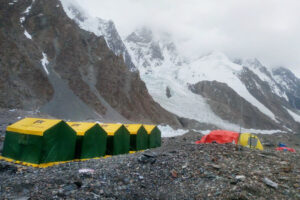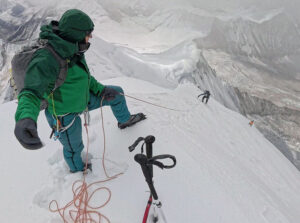By the mid-19th century, most of Europe’s major alpine summits had been scaled. Skip forward to the middle of the swinging 1960s, and all 8,000’ers had likewise toppled. But that hasn’t spelled the end of great challenges for mountaineers. There remain thousands of virgin peaks around the globe, and thousands more unclimbed lines tempting alpine daydreamers. Some are yet to be scaled because they just aren’t that interesting, or they have lain untouched for political or even religious reasons. Others are simply gnarly, very bold, or perhaps beyond even the abilities of our current generation.
It would be too easy to pick a bundle of great alpine challenges from the Himalaya and Karakorum alone — the North Face of the Ogre II, the Everest Horseshoe, etc. Instead, we’ve chosen five varied climbs that differ in style, altitude and geographical location.
K2 in Winter

K2 from a drone at 8,400m. Photo: Bartek Bargiel
Of the 14 peaks above 8,000m, K2 is the only one without a winter ascent, despite attempts dating back four decades. Since the Polish expedition of 1987-88, led by Andre Zawada, there have been less than 10 winter attempts. Earlier this year, Mingma Gyalje’s three-man team made it only to Camp 2 at 6,600m, thanks to a delayed start and mixed weather. The year before, a Russian/Kazakh/Kyrgyz expedition led by Vassily Pivtsov reached a winter high point of 7,634m, still some 1,000m shy of the summit.
During winter, a fierce jet stream brings hurricane-force winds, and temperatures drop below -40, making life difficult for climbers, even at Base Camp. “You must be able to withstand 40-below temperatures and extremely violent winds,” Alex Txikon previously told ExWeb. “The exposure and effort are extreme, and only few alpinists [are capable of] climbing K2 in winter.”
Of those who are, the two main protagonists appear to be Basque Alex Txikon and Kazakh strongman Denis Urubko. Both have recently taken on K2 in winter, with Urubko famously breaking from his teammates to try to reach the summit alone in 2018. Despite supposedly retiring from high-altitude climbing, Urubko is keen for one last try at arguably the number one prize on our list. However, Nanga Parbat held off over 30 winter attempts, so K2 could remain unclimbed during the cold season for years.
Latok 1 North Face

The unclimbed North Face of Latok 1. Photo: Alexander Gukov
Latok 1 (7,145m) itself has only been climbed twice, by a Japanese team via the south side in 1979 and by Tom Livingston and team in 2018. In 1978, Americans George Lowe, Jeff Lowe, Michael Kennedy and Jim Donini spent 26 days on the 2,600m north ridge of Latok 1, a hulking spine of granite and ice that rises abruptly to the heavens from the Choktoi Glacier. The talented and powerful Americans turned back just 150m from the summit, when Jeff Lowe fell semi-conscious with a fever. In 2018, Alexander Gukov and Sergey Glazunov likely reached the top of the north ridge (removing that objective), but not the summit because of poor visibility. On the descent, Glazunov sadly fell to his death.
The 2,000m North Face has been described as the magic line on Latok I, involving “800m of 80-degree mixed ramp leading to a magnificent 600m fat 90-degree vein of pure waterfall ice to gain mixed terrain and eventually the sharp and well-defined ridge that leads directly to the summit.”
Russians Victor Koval, Konstantin Markevich and Alexander Parfenov took a look at the face in 2018, but turned back because of heavy rockfall, and a South Korean team were avalanched off and had to be rescued. Later in the year, Thomas Huber found the wall plastered in snow and spindrift avalanches, and in a state that he and his team considered unclimbable. Huber said: “The North Face seems invincible. If you go there, you have to say‚ ‘Goodbye, life’ –- and then touch and go!”
Hummingbird Ridge – Mount Logan

The exposed Hummingbird Ridge runs 10km from around 2,400m to 5,900m. Photo: Mark Smiley
The curveball on our list, as it’s been climbed already. But this mammoth ridge hasn’t seen a second ascent in the 55 years since the first one, and it’s claimed at least four lives along the way. The Hummingbird Ridge sweeps 10km from the summit of Canada’s highest mountain, 5,959m Mount Logan, to the Seward Glacier below. Logan is a behemoth, with the largest base of any non-volcanic peak, and an isolated summit that makes it the sixth most prominent peak on the planet.
Hummingbird saw its first and only successful ascent in 1965 by a team of six tough alpinists (Dick Long, Allen Steck, Jim Wilson, John Evans, Franklin Coale Sr. and Paul Bacon). For 30 long days, Steck and company tackled the route expedition-style and had the patience to handle such difficulties as the heinously corniced 1,000m ridge now known as the Shovel Traverse. In 1987, two Canadian climbers, Dave Cheesmond and Cathy Freer, died on the Shovel Traverse.
In 1990, Geoffrey Creighton and David Nettle, completed a new route on the south face which joined the Hummingbird Ridge at around 4,300m, before continuing to the summit. Among later attempts at the full ridge, the American Mugs Stump and friends bailed on the lower section of the route after 10 days of effort, and an American team, including guide Mark Smiley, were rebuffed in 2014. “Moving along the ridge was slow going,” declared Smiley on his return. “The snow was deep and loose. The ice was airy and unstable. The rock was broken and hard to protect. Every foot was hard-earned.”
Masherbrum Northeast Face

The unclimbed Northeast Face of Masherbrum (7,821m). Photo: Andreas Gradl
Back to the Karakorum, and to Masherbrum (formerly known as K1). It has seen under 20 ascents since its first in the late 1930s. Even fewer teams have tried the unclimbed Northeast Face, which stretches from 4,800m to 7,800m.
A Russian reconnaissance in 2005 described the route as “futuristic” and strenuous: “3,000m high, and the crux will undoubtedly be the near-vertical yellow rock band starting around 7,000m.”
In 2014, Austria’s David Lama, Hansjorg Auer and Peter Ortner spent over a month at the foot of the face, waiting for clear weather and an avalanche-free passage, but never managed to get going in earnest. Lama described the face as “one of the hardest unclimbed routes left in the world –- sort of like climbing the Eiger, with a Cerro Torre on top.”
Spectre South Spur

The untouched South Spur of Spectre. Photo: Berghaus
To take on the final pick on our list, aspirants will either need deep pockets or a willingness to put some hard miles in (that’s an understatement). Buried deep in the Gothic Mountains of the Transantarctic chain in Antarctica, about 450km down from the South Pole, the dramatic granite spire of The Spectre (2,020m) is located in the most remote mountain range on earth. Spectre was first climbed in 1980 by a 750m route up the north face and northwest ridge, by brothers Mugs and Edward Stump.
Thirty-seven years later, Leo Houlding led a three-man team on a climbing, manhauling and snowkiting expedition to tackle the South Spur. The team were dropped 200km from the Gothic Mountains, then kited 300km or so to the base of Spectre. After unsettled weather, and finding their objective to be more big wall than alpine climb, they decided to do a variation of the original Stump route, leaving the South Spur untouched. They then manhauled and kited 700km back to Union Glacier.






